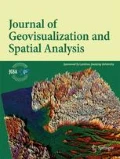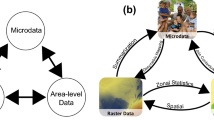Abstract
Developing spatial analytical methods as open source libraries is an important endeavor to enable open and replicable science. However, despite the fact that large geospatial data and geospatial cyberinfrastructure (GeoCI) resources are becoming available, many libraries and toolkits are only initialized and designed for analytics in a desktop environment. Coupling spatial analytical functionality with big data and high-performance computing will result in immediate benefits for multidisciplinary research in terms of addressing challenging socioeconomic and environmental problems, as well as supporting remote collaboration between participants from physically distributed research groups, and assisting informed decision-making. In this article, we present the design and implementation of a general workflow to integrate state-of-the-art open source libraries with GeoCI resources. We also solve various interoperability and replicability issues that arise during the implementation process. The popular open source Python Spatial Analysis Library (PySAL) was selected to build the interoperable Web service, WebPySAL, which was then successfully integrated in GeoCI. With this integration between spatial analytics and cyberinfrastructure, the new GeoCI platform provides easy-to-use, efficient, and interactive exploratory spatial analysis functions to public users. The GeoCI capability is demonstrated through two regional economic case studies of (1) evaluating global spatial autocorrelation and identifying local clusters in the spatial pattern of median household incomes for US counties (with global and local Moran’s I statistics) and (2) modeling the space-time dynamics of per capita incomes at the state level (with spatial Markov statistics).










Similar content being viewed by others
Notes
Please see <http://cici.lab.asu.edu/gci2>
References
Allard S (2012) DataONE: facilitating eScience through collaboration. J eSci Librariansh 1(1):3
Anselin L (1995) Local indicators of spatial association-LISA. Geogr Anal 27(2):93–115
Anselin L, Rey SJ (2012) Spatial econometrics in an age of CyberGIScience. Int J Geograph Inform Sci IJGIS 26(12):2211–2226
Anselin L & Rey SJ (2014) Modern spatial econometrics in practice: a guide to GeoDa, GeoDaSpace and PySAL. GeoDa Press
Anselin L, Rey SJ, Li W (2014) Metadata and provenance for spatial analysis: the case of spatial weights. Int J Geogr Information Sci 28(11):2261–2280
Anselin L, Syabri I, Kho Y (2010) GeoDa: an introduction to spatial data analysis. Handbook of applied spatial analysis. pp 73–89
Astsatryan H, Hayrapetyan A, Narsisian W, Saribekyan A, Asmaryan S, Saghatelyan A, Muradyan V, Guigoz Y, Giuliani G, Ray N (2015) An interoperable Web portal for parallel geoprocessing of satellite image vegetation indices. Earth Sci Inf 8(2):453–460
Bivand R, Anselin L, Berke O al Bernat A, Carvalho M, Chun Y et al (2011) spdep: spatial dependence: weighting schemes, statistics and models. R package version 0.5-31, URL http://CRAN.R-project.org/package=spdep. Retrieved from http://ftp.auckland.ac.nz/software/CRAN/src/contrib/Descriptions/spdep.html
Brandl G (2009) Sphinx: python documentation generator. URL: https://pypi.org/project/Sphinx/10.(last accessed on April 10, 2020)
Čepický J (2007) PyWPS 2.0.0: the presence and the future. Geoinformatics FCE CTU 2:61–64
Cerón M, Fernández-Carmona M, Urdiales C, Sandoval F (2018) Smartphone-based vehicle emission estimation. In: Proceedings of the International Conference on Information Technology & Systems (ICITS 2018). Springer International Publishing, pp 284–293
Cliff AD, Ord JK (1981) Spatial processes, models & applications. Pion, London
Delipetrev B, Jonoski A, Solomatine DP (2014) Development of a web application for water resources based on open source software. Comput Geosci 62:35–42
Dubois G, Schulz M, Skøien J, Bastin L, Peedell S (2013) eHabitat, a multi-purpose Web processing service for ecological modeling. Environ Model Softw 41:123–133
Harris R (2003) Building a GIScience community in cyberspace: reflections on GIScOnline. J Geogr High Educ 27(3):279–295
Kang W, Rey SJ (2018) Conditional and joint tests for spatial effects in discrete Markov chain models of regional income distribution dynamics. Ann Reg Sci 61(1):73–93
Keller GR (2003) GEON (GEOscience network): a first step in creating cyberinfrastructure for the geosciences. Seismol Res Lett 74(4):441–444
Krishnan S, Crosby C, Nandigam V, Phan M, Cowart C, Baru C, Arrowsmith R (2011) OpenTopography: a services oriented architecture for community access to LIDAR topography. In: Proceedings of the 2nd International Conference on Computing for Geospatial Research & Applications. ACM, p 7
Kullback S, Kupperman M, Ku HH (1962) Tests for contingency tables and Markov chains. Technometrics J Stat Phys Chem Eng Sci 4(4):573–608
Laura J, Li W, Rey SJ, Anselin L (2015) Parallelization of a regionalization heuristic in distributed computing platforms – a case study of parallel-p-compact-regions problem. Int J Geograph Inform Sci IJGIS 29(4):536–555
Li W (2018) Lowering the barriers for accessing distributed geospatial big data to advance spatial data science: the PolarHub solution. Ann Am Assoc Geogr 108(3):773–793
Li W, Bhatia V, Cao K (2015a) Intelligent polar cyberinfrastructure: enabling semantic search in geospatial metadata catalogue to support polar data discovery. Earth Sci Inf 8(1):111–123
Li W, Song M, Zhou B, Cao K, Gao S (2015b) Performance improvement techniques for geospatial Web services in a cyberinfrastructure environment–a case study with a disaster management portal. Comput Environ Urban Syst 54:314–325
Li W, Shao H, Wang S, Zhou X, Wu S (2016a) A2CI: a cloud-based, service-oriented geospatial cyberinfrastructure to support atmospheric research. In: Cloud computing in ocean and atmospheric sciences. Academic Press, pp 137–161
Li W, Wang S, Bhatia V (2016b) PolarHub: a large-scale Web crawling engine for OGC service discovery in cyberinfrastructure. Comput Environ Urban Syst 59:195–207
Li W, Wu S, Song M, Zhou X (2016c) A scalable cyberinfrastructure solution to support big data management and multivariate visualization of time-series sensor observation data. Earth Sci Inf 9(4):449–464
Li W, Goodchild MF, Anselin L, Weber KT (2019a) A smart service-oriented CyberGIS framework for solving data-intensive geospatial problems. In: CyberGIS for geospatial discovery and innovation. Springer, Dordrecht, pp 189–211
Li W, Song M, Tian Y (2019b) An ontology-driven cyberinfrastructure for intelligent spatiotemporal question answering and open knowledge discovery. ISPRS Int J Geo Inf 8(11):496
Li X, Di L, Han W, Zhao P, Dadi U (2010) Sharing geoscience algorithms in a Web service-oriented environment (GRASS GIS example). Comput Geosci 36(8):1060–1068
McMillen DP, McDonald JF (1991) A Markov chain model of zoning change. J Urban Econ 30(2):257–270
Mihon D, Colceriu V, Bacu V, Gorgan D (2013) Grid based processing of satellite images in GreenLand Platform. Int J Adv Comput Sci Appl 3:41–49
Neteler M, Bowman MH, Landa M, Metz M (2012) GRASS GIS: a multi-purpose open source GIS. Environ Model Softw 31:124–130
Pebesma E (2012) spacetime: spatio-temporal data in R. J Stat Softw 51(7). https://doi.org/10.18637/jss.v051.i07
Quah DT (1993) Empirical cross-section dynamics in economic growth. Eur Econ Rev 37(2-3):426–434
Rajib MA, Merwade V, Kim IL, Zhao L, Song C, Zhe S (2016) SWATShare – a Web platform for collaborative research and education through online sharing, simulation and visualization of SWAT models. Environ Model Softw 75:498–512
Rey SJ (2014) Python Spatial Analysis Library (PySAL): an update and illustration. In: Brunsdon C, SIngleton A (eds) Geocomputation. Sage
Rey SJ (2016) Space–time patterns of rank concordance: local indicators of mobility association with application to spatial income inequality dynamics. Ann Am Assoc Geographers 106(4):788–803
Rey SJ, Anselin L (2010) PySAL: a python library of spatial analytical methods. In: Fischer MM, Getis A (eds) Handbook of applied spatial analysis: software tools, methods and applications. Springer, Berlin, Heidelberg, pp 175–193
Rey SJ, Anselin L, Li X, Pahle R, Laura J, Li W, Koschinsky J (2015) Open geospatial analytics with PySAL. ISPRS Int J Geo Inf 4(2):815–836
Rey SJ, Janikas MV (2010) STARS: space-time analysis of regional systems, In Handbook of applied spatial analysis (pp. 91-112). Springer, Berlin, Heidelberg
Rey SJ, Kang W, Wolf L (2016) The properties of tests for spatial effects in discrete Markov chain models of regional income distribution dynamics. J Geogr Syst 18(4):377–398
Rey SJ, Murray AT, Grubesic TH, Mack E, Wei R, Anselin L, Griffin M (2014) Sex offender residential movement patterns: a Markov chain analysis. Prof Geogr J Assoc Am Geogr 66(1):102–111
Rodero Castro I, Parashar M (2016) Architecting the cyberinfrastructure for National Science Foundation Ocean Observatories Initiative (OOI). In: Instrumentation viewpoint, vol 19. SARTI, pp 99–101
Rinner C, Keßler C, Andrulis S (2008) The use of Web 2.0 concepts to support deliberation in spatial decision-making. Comput Environ Urban Syst 32(5):386–395
Steiniger S, Hunter AJS (2013) The 2012 free and open source GIS software map - a guide to facilitate research, development, and adoption. Comput Environ Urban Syst 39:136–150
Sugumaran R, Meyer JC, Davis J (2009) A Web-based environmental decision support system for environmental planning and watershed management. In: Handbook of applied spatial analysis, pp 703–718
Sun Y, Li S (2016) Real-time collaborative GIS: a technological review. ISPRS J Photogramm Remote Sens Off Publ Int Soc Photogramm Remote Sens 115:143–152
Swain NR, Latu K, Christensen SD, Jones NL, Nelson EJ, Ames DP, Williams GP (2015) A review of open source software solutions for developing water resources Web applications. Environ Model Softw 67:108–117
Song M, Li W, Zhou B, Lei T (2016) Spatiotemporal data representation and its effect on the performance of spatial analysis in a cyberinfrastructure environment–a case study with raster zonal analysis. Comput Geosci 87:11–21
Shao H, Li W (2018) A comprehensive optimization strategy for real-time spatial feature sharing and visual analytics in cyberinfrastructure. Int J Digit Earth:1–20
Unsworth J (2008) Cyber infrastructure for the humanities and social sciences. Sydney University Press
Veenendaal B (2015) Using the geospatial Web to deliver and teach GIScience education programs. ISPRS - Int Arch Photogramm Remote Sens Spat Inform Sci XL-6/W1:17–21
Wang FZ, Helian N, Wu S, Guo Y, Deng DY, Meng L et al (2009) Eight times acceleration of geospatial data archiving and distribution on the grids. IEEE Trans Geosci Remote Sens Publ IEEE Geosci Remote Sens Soc 47(5):1444–1453
Wang S (2013) CyberGIS: blueprint for integrated and scalable geospatial software ecosystems. Int J Geograph Inform Sci IJGIS 27(11):2119–2121
Wang S, Armstrong MP (2009) A theoretical approach to the use of cyberinfrastructure in geographical analysis. Int J Geograph Inform Sci IJGIS 23(2):169–193
Wang S, Liu Y (2009) TeraGrid GIScience Gateway: bridging cyberinfrastructure and GIScience. Int J Geograph Inform Sci IJGIS 23(5):631–656
Wang Y, Gui Z, Wu H, Peng D, Wu J, Cui Z (2020) Optimizing and accelerating space–time Ripley’s K function based on Apache Spark for distributed spatiotemporal point pattern analysis. Futur Gener Comput Syst 105:96–118
Warmerdam F (2008) The geospatial data abstraction library. In: Open source approaches in spatial data handling. Springer, Berlin, Heidelberg, pp 87–104
Wu A, Convertino G, Ganoe C, Carroll JM, Zhang X (luke) (2013) Supporting collaborative sense-making in emergency management through geo-visualization. Int J Hum Comput Stud 71(1):4–23
Wu H, You L, Gui Z, Hu K, Shen P (2015) GeoSquare: collaborative geoprocessing models’ building, execution and sharing on Azure Cloud. Ann GIS 21(4):287–300
Funding
This research was funded in part by National Science Foundation, grant number 1455349, 1831615, 1937908, 1936677.
Author information
Authors and Affiliations
Corresponding author
Ethics declarations
This paper is compliant with ethical standards.
Conflicts of Interest
The authors declare that they have no conflict of interest.
Additional information
Publisher’s Note
Springer Nature remains neutral with regard to jurisdictional claims in published maps and institutional affiliations.
Rights and permissions
About this article
Cite this article
Shao, H., Li, W., Kang, W. et al. When Spatial Analytics Meets Cyberinfrastructure: an Interoperable and Replicable Platform for Online Spatial-Statistical-Visual Analytics. J geovis spat anal 4, 17 (2020). https://doi.org/10.1007/s41651-020-00056-5
Published:
DOI: https://doi.org/10.1007/s41651-020-00056-5




